
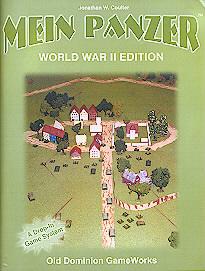
| |
Mein Panzer is a Drop-In Game System, by which the publishers
mean that the rules comprise a core set of armor rules plus a series of optional rules
modules. Intended as a fast-paced game combining historical accuracy and playability.
The game is played in a series of turns, each of which is composed of several identical phases. At the start of the turn, both players roll to see who goes first. Then, during each phase, both players sequentially may activate one of their units. (In larger games, it is necessary to activate more than one unit per player per phase.) An activated unit - generally, a platoon - may take both an Action and a Bonus Move. The Action can take place before, after, or during movement, and can be firing, moving, going into overwatch (to wait for opportunity fire), hiding (taking cover), or recovering (clearing misfires, reloading, or recovering from bad morale results). The Bonus Move is simply a movement action - and note that a unit can move twice, by using its Bonus Move plus spending its standard Action on movement. Units have two movement ratings (cross country and road), and pay a movement penalty for starting any move action in difficult terrain. Rules allow turning in place, pushing, road blocks, and ramming. If a stand moves near an enemy stand, that stand has a chance (based on Troop Quality) to respond with a Reactionary Action (move or fire, once per turn per stand). 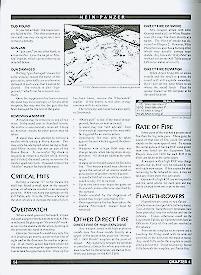 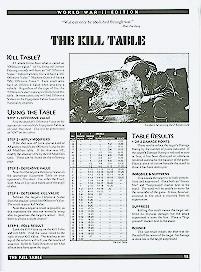 A stand's chance to hit is based on its quality, modified by vehicle type (as listed in the equipment charts) and situation (i.e., movement, cover, range, etc.). Some vehicles may take more than one shot per action. If the roll is equal to or less than the modified to-hit number, a hit is scored. Lucky or unlucky rolls result in Critical Hits (bonus damage) or Misfires (dud round, weapon jams, or weapon unusable). Damage is resolved by figuring the Kill Value, determined by firing vehicle's offensive rating and ammo type, and target's defensive value (for front, rear, side, or top), and comparing this on a chart with the results of a dieroll. Possible outcomes are "bounce," suppression, immobilization, and 1 or 2 points of damage. Damaged vehicles suffer penalties to movement and fire, and are destroyed when total damage equals its damage rating. A suppressed stand can take no action until it recovers (required a Recovery Action and a successful Troop Quality roll). The core rules also cover terrain set-up, deployment, spotting, fields of fire, smoke, tactical reconnaissance, off-board reserves, direct fire of high explosive, and flamethrowers. A point system is provided to aid in scenario design. Additional "modules," included in the rulebook, allow players to add optional rules according to their interests and scenario needs. These modules are:
Crusade at Sidi Rezegh (2 pages) is a sample scenario based on the historical fighting on 21 November 1941 for a critical airfield during Operation Crusader (North Africa). The rulebook also includes a bibliography, index, Transport Tracker form, and a Playsheet (roster). 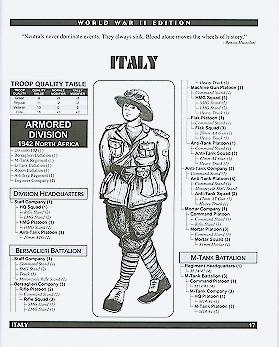 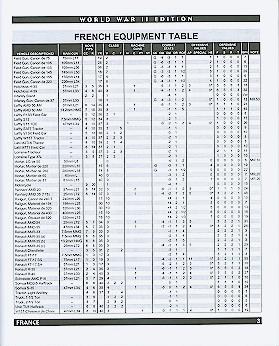 The data booklet provides vehicle data for France, Germany, Italy, Japan, the Soviet Union, the United Kingdom, and the United States. Over 1000 entries cover tanks, artillery, aircraft, trains, and landing craft. In addition, the following TO&Es are provided:
| |||||||||||||||||
|---|---|---|---|---|---|---|---|---|---|---|---|---|---|---|---|---|---|---|
| Period | World War II | |||||||||||||||||
| Scale |
| |||||||||||||||||
| Basing |
| |||||||||||||||||
| Contents |
| |||||||||||||||||
| Designer | Jonathan W. Coulter (jcoulter@odgw.com) | |||||||||||||||||
| Publisher | Published 1998 by Old Dominion Gameworks |
The publisher has announced that Mein Panzer is to be expanded to other periods:
Following these releases, the publisher plans to bring out the Mein Panzer Companion, which will provide advanced rules for all versions of the game.
If you would like to add your opinion to this webpage, use the following form or send email to the editor.
|
The purpose of the list is to keep players informed of official changes, website updates, and new products, as well as providing games with a forum to exchange ideas, house rules or answer questions. To subscribe, send an empty message to meinpanzer-subscribe@makelist.com. You can post messages to its members via e-mail at: meinpanzer@egroups.com. You can also read and post group messages on the Web: http://www.eGroups.com/list/meinpanzer. Please direct any comments or questions about the group to the group moderator at meinpanzer-owner@egroups.com. If you have other questions, visit http://www.eGroups.com/info/help.html. |
If you know of any resources for this game, or if you have material you would like to make available to the Net, please let us know.
| Last Updates | |
|---|---|
| 26 May 1999 | page first published |
| Comments or corrections? | |